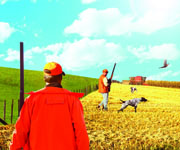
The best idea in hunting access since the invention of the cattle guard is in danger of being killed in its crib.
It’s a federal program that, like most government programs, has an unwieldy name: the Voluntary Public Access and Habitat Incentive Program, or VPA-HIP. Known more popularly as Open Fields, what this program has done, quietly and successfully in its first two years of life, is open the gate to hundreds of thousands of acres of private farmland for hunters and fishermen.
There’s a good chance you have participated in this program without even knowing it. The U.S. Department of Agriculture has distributed federal funds, some $50 million, to states that develop hunting-access programs on participating private land. In South Dakota, pheasant hunters who access ground enrolled in the state’s Walk-In Area program are benefitting from Open Fields funding. Same with California’s SHARE (Shared Habitat Alliance for Recreational Enhancement—see what I mean about clunky names?). And in Kentucky, Georgia, Pennsylvania, and Virginia, the program has paid landowners to open their gates to dove and deer hunters and small-stream anglers.
In two years, 29 states and Native American tribes divided up this federal funding, first proposed under the second Bush administration and authorized during Obama’s first year in office, and unlocked more than 300,000 acres of land. The program is voluntary; it is intended to sweeten landowners’ participation in Farm Bill programs such as Conservation Reserve Program and Wildlife Habitat Incentives Program, also known as WHIP. In some cases, participating farmers can get an additional payment of $10 per acre of land enrolled in CRP if they provide hunting access.
“It’s called an access and habitat program, but the stress is firmly on access,” says David Hoge, a USDA program specialist and one of the architects of the program. “A lot of landowners who participate in USDA programs are receptive to providing access to sportsmen. They just need a reason to do it. This program gives them the incentive.”
And it’s been a hugely cost-effective incentive. Consider that hunting is a revenue-positive pursuit. In other words, hunting makes money—for rural communities, for retailers, for state wildlife agencies. Then consider that access equals hunting. The continued participation of many hunters depends on their having a place to do it. To complete the equation, access makes money.
Now consider that the 2008 Food, Conservation, and Energy Act—better known as the 2008 Farm Bill—which authorized and funded the Open Fields program, totals about $285 billion. It’s a huge, messy, confounding piece of legislation, full of subsidies, food-security considerations, and few public-policy priorities that are revenue-positive. The Open Fields component totals less than one-fifth of one percent of the total.
And yet, President Obama has proposed completely eliminating funding for Open Fields in the leaner 2012 Farm Bill.
“Farm Bill programs like VPA-HIP are critical to the more than $95 billion in economic activity annually contributed by hunting and angling,” says Jennifer Mock Schaeffer of the Association of Fish & Wildlife Agencies.
Will Open Fields be remembered as one of the few federal programs that actually closed the gap between sportsmen and landowners? Unfortunately, it may not live long enough for us to know for sure.
From the March 2012 issue of Outdoor Life magazine.
